Tao Peng
CryptoX : Compositional Reasoning Evaluation of Large Language Models
Feb 08, 2025Abstract:The compositional reasoning capacity has long been regarded as critical to the generalization and intelligence emergence of large language models LLMs. However, despite numerous reasoning-related benchmarks, the compositional reasoning capacity of LLMs is rarely studied or quantified in the existing benchmarks. In this paper, we introduce CryptoX, an evaluation framework that, for the first time, combines existing benchmarks and cryptographic, to quantify the compositional reasoning capacity of LLMs. Building upon CryptoX, we construct CryptoBench, which integrates these principles into several benchmarks for systematic evaluation. We conduct detailed experiments on widely used open-source and closed-source LLMs using CryptoBench, revealing a huge gap between open-source and closed-source LLMs. We further conduct thorough mechanical interpretability experiments to reveal the inner mechanism of LLMs' compositional reasoning, involving subproblem decomposition, subproblem inference, and summarizing subproblem conclusions. Through analysis based on CryptoBench, we highlight the value of independently studying compositional reasoning and emphasize the need to enhance the compositional reasoning capabilities of LLMs.
UI-TARS: Pioneering Automated GUI Interaction with Native Agents
Jan 21, 2025Abstract:This paper introduces UI-TARS, a native GUI agent model that solely perceives the screenshots as input and performs human-like interactions (e.g., keyboard and mouse operations). Unlike prevailing agent frameworks that depend on heavily wrapped commercial models (e.g., GPT-4o) with expert-crafted prompts and workflows, UI-TARS is an end-to-end model that outperforms these sophisticated frameworks. Experiments demonstrate its superior performance: UI-TARS achieves SOTA performance in 10+ GUI agent benchmarks evaluating perception, grounding, and GUI task execution. Notably, in the OSWorld benchmark, UI-TARS achieves scores of 24.6 with 50 steps and 22.7 with 15 steps, outperforming Claude (22.0 and 14.9 respectively). In AndroidWorld, UI-TARS achieves 46.6, surpassing GPT-4o (34.5). UI-TARS incorporates several key innovations: (1) Enhanced Perception: leveraging a large-scale dataset of GUI screenshots for context-aware understanding of UI elements and precise captioning; (2) Unified Action Modeling, which standardizes actions into a unified space across platforms and achieves precise grounding and interaction through large-scale action traces; (3) System-2 Reasoning, which incorporates deliberate reasoning into multi-step decision making, involving multiple reasoning patterns such as task decomposition, reflection thinking, milestone recognition, etc. (4) Iterative Training with Reflective Online Traces, which addresses the data bottleneck by automatically collecting, filtering, and reflectively refining new interaction traces on hundreds of virtual machines. Through iterative training and reflection tuning, UI-TARS continuously learns from its mistakes and adapts to unforeseen situations with minimal human intervention. We also analyze the evolution path of GUI agents to guide the further development of this domain.
SDM-Car: A Dataset for Small and Dim Moving Vehicles Detection in Satellite Videos
Dec 24, 2024



Abstract:Vehicle detection and tracking in satellite video is essential in remote sensing (RS) applications. However, upon the statistical analysis of existing datasets, we find that the dim vehicles with low radiation intensity and limited contrast against the background are rarely annotated, which leads to the poor effect of existing approaches in detecting moving vehicles under low radiation conditions. In this paper, we address the challenge by building a \textbf{S}mall and \textbf{D}im \textbf{M}oving Cars (SDM-Car) dataset with a multitude of annotations for dim vehicles in satellite videos, which is collected by the Luojia 3-01 satellite and comprises 99 high-quality videos. Furthermore, we propose a method based on image enhancement and attention mechanisms to improve the detection accuracy of dim vehicles, serving as a benchmark for evaluating the dataset. Finally, we assess the performance of several representative methods on SDM-Car and present insightful findings. The dataset is openly available at https://github.com/TanedaM/SDM-Car.
DefFiller: Mask-Conditioned Diffusion for Salient Steel Surface Defect Generation
Dec 20, 2024



Abstract:Current saliency-based defect detection methods show promise in industrial settings, but the unpredictability of defects in steel production environments complicates dataset creation, hampering model performance. Existing data augmentation approaches using generative models often require pixel-level annotations, which are time-consuming and resource-intensive. To address this, we introduce DefFiller, a mask-conditioned defect generation method that leverages a layout-to-image diffusion model. DefFiller generates defect samples paired with mask conditions, eliminating the need for pixel-level annotations and enabling direct use in model training. We also develop an evaluation framework to assess the quality of generated samples and their impact on detection performance. Experimental results on the SD-Saliency-900 dataset demonstrate that DefFiller produces high-quality defect images that accurately match the provided mask conditions, significantly enhancing the performance of saliency-based defect detection models trained on the augmented dataset.
An Empirical Study on Information Extraction using Large Language Models
Sep 04, 2024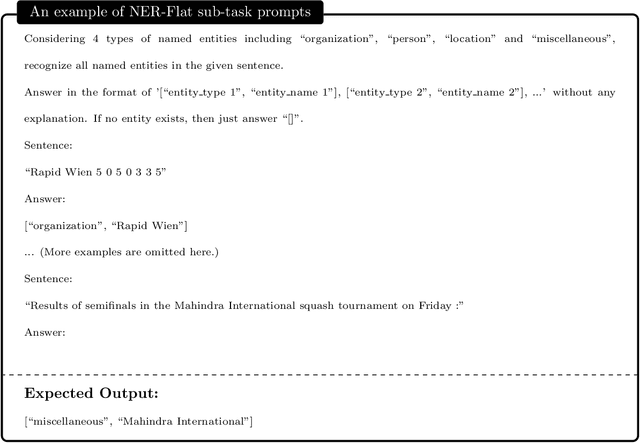
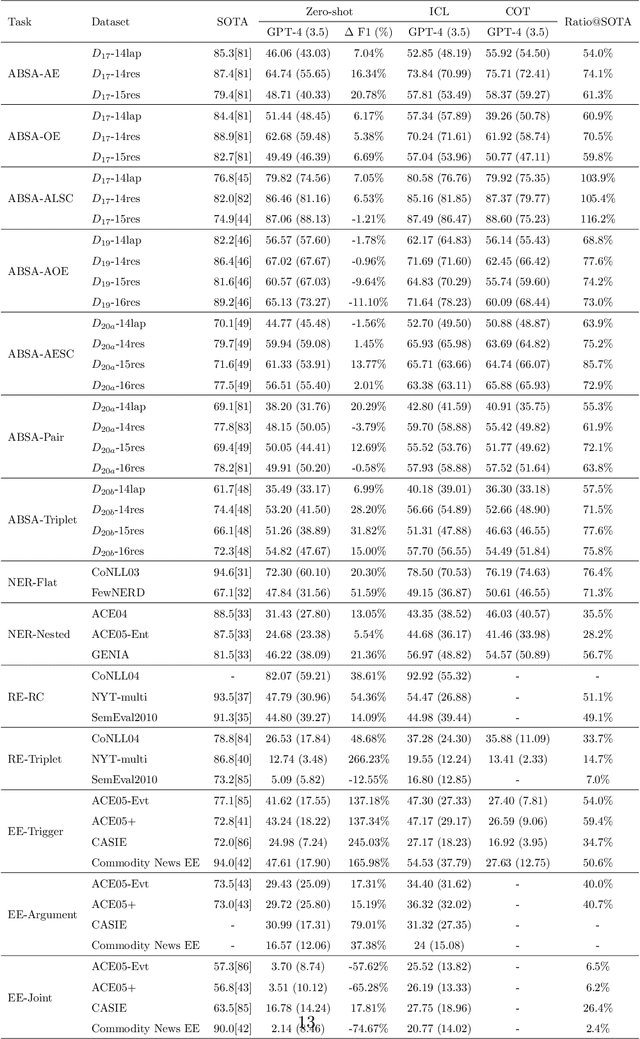
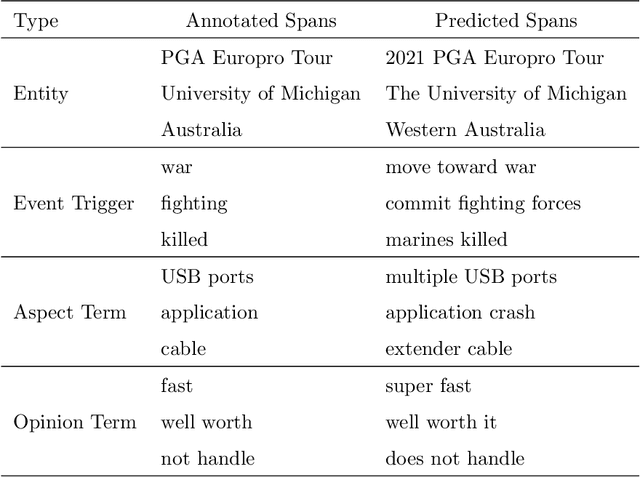
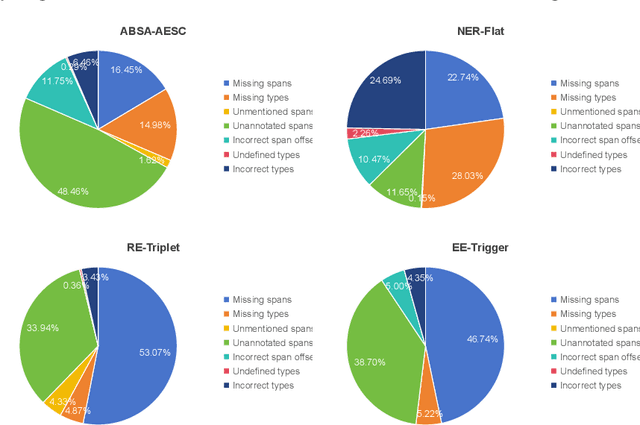
Abstract:Human-like large language models (LLMs), especially the most powerful and popular ones in OpenAI's GPT family, have proven to be very helpful for many natural language processing (NLP) related tasks. Therefore, various attempts have been made to apply LLMs to information extraction (IE), which is a fundamental NLP task that involves extracting information from unstructured plain text. To demonstrate the latest representative progress in LLMs' information extraction ability, we assess the information extraction ability of GPT-4 (the latest version of GPT at the time of writing this paper) from four perspectives: Performance, Evaluation Criteria, Robustness, and Error Types. Our results suggest a visible performance gap between GPT-4 and state-of-the-art (SOTA) IE methods. To alleviate this problem, considering the LLMs' human-like characteristics, we propose and analyze the effects of a series of simple prompt-based methods, which can be generalized to other LLMs and NLP tasks. Rich experiments show our methods' effectiveness and some of their remaining issues in improving GPT-4's information extraction ability.
AI-based Automatic Segmentation of Prostate on Multi-modality Images: A Review
Jul 09, 2024



Abstract:Prostate cancer represents a major threat to health. Early detection is vital in reducing the mortality rate among prostate cancer patients. One approach involves using multi-modality (CT, MRI, US, etc.) computer-aided diagnosis (CAD) systems for the prostate region. However, prostate segmentation is challenging due to imperfections in the images and the prostate's complex tissue structure. The advent of precision medicine and a significant increase in clinical capacity have spurred the need for various data-driven tasks in the field of medical imaging. Recently, numerous machine learning and data mining tools have been integrated into various medical areas, including image segmentation. This article proposes a new classification method that differentiates supervision types, either in number or kind, during the training phase. Subsequently, we conducted a survey on artificial intelligence (AI)-based automatic prostate segmentation methods, examining the advantages and limitations of each. Additionally, we introduce variants of evaluation metrics for the verification and performance assessment of the segmentation method and summarize the current challenges. Finally, future research directions and development trends are discussed, reflecting the outcomes of our literature survey, suggesting high-precision detection and treatment of prostate cancer as a promising avenue.
Defect Image Sample Generation With Diffusion Prior for Steel Surface Defect Recognition
May 03, 2024
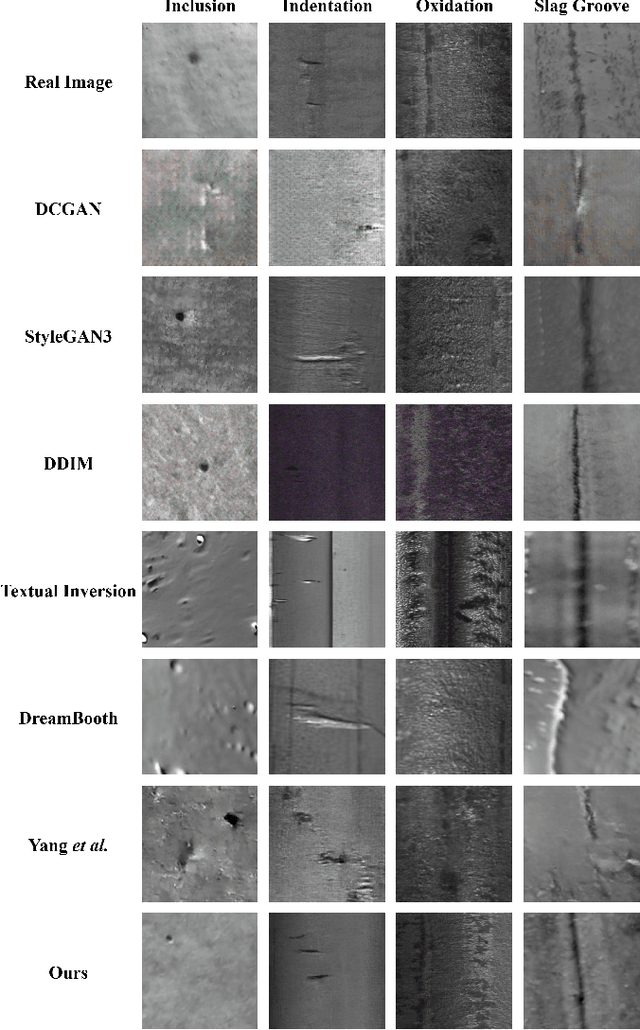


Abstract:The task of steel surface defect recognition is an industrial problem with great industry values. The data insufficiency is the major challenge in training a robust defect recognition network. Existing methods have investigated to enlarge the dataset by generating samples with generative models. However, their generation quality is still limited by the insufficiency of defect image samples. To this end, we propose Stable Surface Defect Generation (StableSDG), which transfers the vast generation distribution embedded in Stable Diffusion model for steel surface defect image generation. To tackle with the distinctive distribution gap between steel surface images and generated images of the diffusion model, we propose two processes. First, we align the distribution by adapting parameters of the diffusion model, adopted both in the token embedding space and network parameter space. Besides, in the generation process, we propose image-oriented generation rather than from pure Gaussian noises. We conduct extensive experiments on steel surface defect dataset, demonstrating state-of-the-art performance on generating high-quality samples and training recognition models, and both designed processes are significant for the performance.
RoMe: Towards Large Scale Road Surface Reconstruction via Mesh Representation
Jun 20, 2023



Abstract:Large-scale road surface reconstruction is becoming important to autonomous driving systems, as it provides valuable training and testing data effectively. In this paper, we introduce a simple yet efficient method, RoMe, for large-scale Road surface reconstruction via Mesh representations. To simplify the problem, RoMe decomposes a 3D road surface into a triangle-mesh and a multilayer perception network to model the road elevation implicitly. To retain fine surface details, each mesh vertex has two extra attributes, namely color and semantics. To improve the efficiency of RoMe in large-scale environments, a novel waypoint sampling method is introduced. As such, RoMe can properly preserve road surface details, with only linear computational complexity to road areas. In addition, to improve the accuracy of RoMe, extrinsics optimization is proposed to mitigate inaccurate extrinsic calibrations. Experimental results on popular public datasets also demonstrate the high efficiency and accuracy of RoMe.
Is Information Extraction Solved by ChatGPT? An Analysis of Performance, Evaluation Criteria, Robustness and Errors
May 23, 2023Abstract:ChatGPT has stimulated the research boom in the field of large language models. In this paper, we assess the capabilities of ChatGPT from four perspectives including Performance, Evaluation Criteria, Robustness and Error Types. Specifically, we first evaluate ChatGPT's performance on 17 datasets with 14 IE sub-tasks under the zero-shot, few-shot and chain-of-thought scenarios, and find a huge performance gap between ChatGPT and SOTA results. Next, we rethink this gap and propose a soft-matching strategy for evaluation to more accurately reflect ChatGPT's performance. Then, we analyze the robustness of ChatGPT on 14 IE sub-tasks, and find that: 1) ChatGPT rarely outputs invalid responses; 2) Irrelevant context and long-tail target types greatly affect ChatGPT's performance; 3) ChatGPT cannot understand well the subject-object relationships in RE task. Finally, we analyze the errors of ChatGPT, and find that "unannotated spans" is the most dominant error type. This raises concerns about the quality of annotated data, and indicates the possibility of annotating data with ChatGPT. The data and code are released at Github site.
Document-level Relation Extraction with Relation Correlations
Dec 20, 2022Abstract:Document-level relation extraction faces two overlooked challenges: long-tail problem and multi-label problem. Previous work focuses mainly on obtaining better contextual representations for entity pairs, hardly address the above challenges. In this paper, we analyze the co-occurrence correlation of relations, and introduce it into DocRE task for the first time. We argue that the correlations can not only transfer knowledge between data-rich relations and data-scarce ones to assist in the training of tailed relations, but also reflect semantic distance guiding the classifier to identify semantically close relations for multi-label entity pairs. Specifically, we use relation embedding as a medium, and propose two co-occurrence prediction sub-tasks from both coarse- and fine-grained perspectives to capture relation correlations. Finally, the learned correlation-aware embeddings are used to guide the extraction of relational facts. Substantial experiments on two popular DocRE datasets are conducted, and our method achieves superior results compared to baselines. Insightful analysis also demonstrates the potential of relation correlations to address the above challenges.
 Add to Chrome
Add to Chrome Add to Firefox
Add to Firefox Add to Edge
Add to Edge